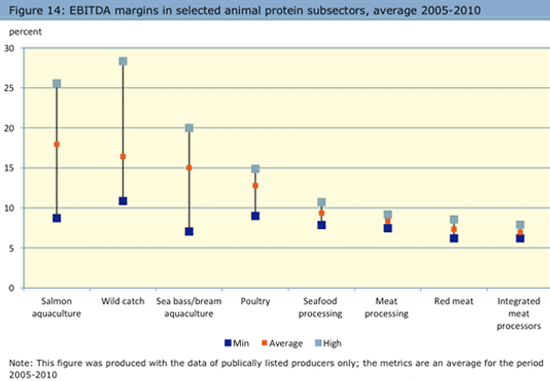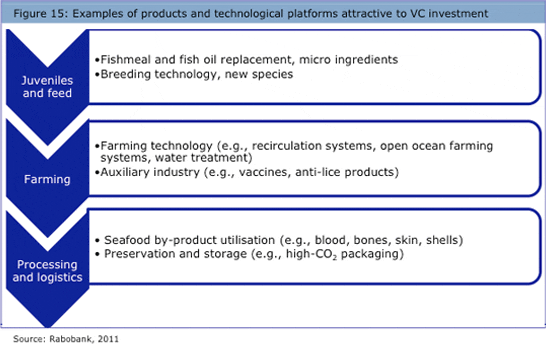Wild-catch subsectors look for diversification
Consolidation is a key dynamic in the wild-catch subsectors, driven by changing quota regulations and the potential to achieve economies of scale by efficient utilisation of large vessels.
The leading harvesters of pelagics and whitefish are large companies compared to others in the rest of the seafood sector. They have the funds available to be key investors in the industry, and they are particularly interested in the aquaculture sector, especially salmon farming. The leading producers of small pelagics, although highly cash generative, have limited opportunities for growth other than by acquisition of peers or through vertical integration. Aquaculture, on the other hand, is a growth sector.
Despite the clear differences between aquaculture and wild catch, there is potential for synergy in the marketing and distribution of the end-product. For producers of small pelagics, there is also potential for vertical integration as small pelagics are the raw material used to produce fishmeal and fish oil, the key ingredients in the feed of carnivorous fish species such as salmon.
Pescanova, the leader in Spain’s frozen seafood market, is an example of a vertically integrated whitefish harvester and processor that has repeatedly invested in the aquaculture sector during the last decade. Pescanova has gradually transformed into a diversified and vertically integrated producer, and is just one example of wild-catch producers diversifying into aquaculture (see Figure 1).
Figure 1: Examples of wild-catch industry investments into aquaculture subsectors
| Investor | Wild-catch sector | Investment | Location |
|---|---|---|---|
| Pescanova | Whitefish | Shrimp aquaculture | Central America |
| Salmon aquaculture | Chile | ||
| Turbot aquaculture | Portugal | ||
| Tilapia aquaculture | Brazil | ||
| Sanford | Whitefish and pelagics | Salmon aquaculture | New Zealand |
| Mussel aquaculture | New Zealand | ||
| Pacific Andes | Whitefish | Salmon aquaculture | Australia |
| Austevoll Seafood | Small pelagics | Salmon aquaculture | Norway |
| Camanchaca | Small pelagics | Salmon aquaculture | Chile |
| Sociedad Pescuera Coloso |
Whitefish and pelagics | Salmon aquaculture | Chile |
| Blumar Seafoods | Small pelagics and whitefis | Salmon aquaculture | Chile |
| Mussel aquaculture | Chile | ||
| Source: Rabobank, 2011 | |||
We expect this trend of diversification to continue and accelerate. As key wild-catch regions become fully consolidated and reach the legal limits of quota ownership, more producers will choose to venture into the higher growth aquaculture sector. Downstream synergies will not be the only attraction of this investment strategy. Given that the dynamics which create volatility in wild-catch operations (such as TAC quota changes) are completely different to those in aquaculture—where disease outbreaks are a major risk—the combined entity is likely have a more stable cash flow.
In the salmon farming industry, we expect a renewed consolidation wave. As Atlantic salmon spot prices have plummeted (close to or under the cost of production for many producers) a range of mostly mid-sized producers will require additional equity financing to get through the current down cycle. This will likely be an opportunity for the market leaders to consolidate the industry further or for newcomers to enter salmon aquaculture through acquisitions.
However, it should be noted that if adjusted for cyclicality, salmon aquaculture is in fact one of the best capitalised seafood industries. Most of the industry is located in developed, mature economies where access to investment capital is typically strong. In Chile, access to capital is good compared to other developing countries. The relative scale of the leading salmon producers, combined with the fact that many are publically listed companies, indicates strong access to capital.
Consequently, we expect the leading salmon farmers to become key investors in other aquaculture subsectors, which are more fragmented and have fewer sources of capital. A number of leading salmon farmers have already made investments in other aquaculture sectors (see Figure 2).
Figure 2: Examples of salmon-industry investments in other aquaculture subsectors
| Investor | Sector | Investment | Location |
|---|---|---|---|
| AquaChile | Salmon farming | Tilapia aquaculture | Costa Rica |
| Cooke Aquaculture | Salmon farming | Sea bass and sea bream aquaculture | Spain |
| Marine Harvest | Salmon farming | Halibut aquaculture | Norway |
| Cermaq | Salmon farming and salmon feed | Pangasius feed | Vietnam |
| Multiexport Foods | Salmon farming | Mussels aquaculture | Chile |
| Source: Rabobank, 2011 | |||
The primary motivation for salmon farmers to invest in other aquaculture sectors is to leverage their knowledge of fish husbandry and achieve synergy in feed procurement, in marketing and distribution activities and to achieve species diversification in order to mitigate the effect of the salmon cycle.
Investment opportunities upstream
The seafood processing industry (e.g. frozen seafood producers) has also undergone a consolidation wave in the last few decades. Facing supplier rationalisation from retailers on the one hand and volatile seafood commodities on the other, seafood processors have been consolidating. Local processors are merging and becoming regional leaders; most of their acquisitions are targeting peers or similar processors with a unique brand or a specific niche position. An example of this type of consolidation is Findus Group, which was created by the merger of three seafood processors active in northwestern Europe.
It is noteworthy that few of the leading seafood processors are looking for upstream vertical integration despite volatile spot prices of seafood commodities and the higher average profitability of the upstream part of the seafood industry. By investing in the upstream part of the value chain, seafood processors are also investing in a structurally more profitable sector despite its more volatile profitability (see Figure 3).
However, the upstream part of the seafood industry is also characterised by high entry barriers, for instance, in the form of legislation that prevents foreign ownership of fishing quotas. Investments in this part of the value chain require significant capital for assets such as fishing vessels, fishing quotas or farming licences. European and US processors face an added challenge; frequently, upstream activities are located in geographically distant regions. For instance, if an EU or US tropical shrimp processor were to choose to vertically integrate, it would need to invest in South East Asia or Central America.
Typically, only processors with high exposure to a single species have opted for vertical integration. For instance, many of the largest tuna canners have invested in fishing vessels which usually cover a part of their raw material need. Another example is the Polish salmon smoker Morpol, which has acquired salmon farming assets in Scotland and Norway to increase its internal source of supply.
Our expectation is that more leading seafood processors will consider investing upstream in the seafood value chain—and not only the processors with high single-species exposure. They will be motivated by the need to control supply quality and mitigate raw material price fluctuation. The benefits to be gained from the high profitability and high growth of some upstream activities, such as salmon or shrimp aquaculture, will also stimulate investment. Companies such as Pescanova in Spain and Sanford in New Zealand have demonstrated that being a diversified seafood processor with vertical integration into both wild catch and aquaculture can provide not only strong profitability and stable sales growth, but also a resilient business model which fully benefits from the diversity of the seafood industry.

In the future, PE investors could play a role in the proliferation of this diversified and vertically integrated seafood business model. Generally, PE investors have avoided the upstream part of the seafood industry since cyclicality, biological assets, a dynamic business environment with rapid technology advances or frequent legislative changes are not their ideal environment. This investor group is currently active only among the seafood processors since a stable and diversified business can carry significantly more debt.
However, the combination of investment in a processor and in high-growth upstream activities such as salmon, shrimp or tilapia aquaculture can provide both stable cash flows and strong potential for growth. An example of this investment strategy is displayed by the PE fund Paine & Partners, which through its investment in Icicle Seafoods, a leading US seafood processor and whitefish harvester, has also invested in the salmon aquaculture industry.
Venture capital (VC) is another financial investor group which is expected to become increasingly active in the seafood industry and particularly in aquaculture. VC inventors seek out innovative and high growth sectors. The dynamics of virtually every part of the aquaculture value chain provide opportunities for VC investors (see Figure 4).

As the aquaculture sector has grown from a relatively small industry only 20 years ago to a large sector producing over 56 million tonnes of seafood and an additional 17 million tonnes of farmed seaweeds and algae, its attraction for innovators to invest resources in creating breakthrough technological solutions has also increased.
Opportunities for animal protein industry investors
Finally, the broader animal proteins industry could also be a potential investor in the seafood industry. The animal protein industry is both larger and more consolidated than the seafood industry. Consequently, the top-five largest animal protein producers have annual sales between US$ 10 billion and US$ 30 billion, far larger than any seafood or aquaculture company. It is interesting to observe that the producers and processors of terrestrial proteins such as pork, beef and poultry have not invested in aquaculture or fisheries.
There are some processors which have extended brands from the meat sector to the seafood industry and vice versa, but the leading animal proteins producers have not made any significant acquisitions, investments or joint ventures with aquaculture producers. In Rabobank’s opinion, there is synergy between the two sectors. Downstream, logistics operations, cool chains and other distribution facilities are similar between the two industries. Relationships with retailers and food service customers can also be leveraged. Upstream in the value chain there is potential for even more synergy. Most feed producers, many breeders and/or genetics companies and auxiliary service providers (such as vaccine suppliers) are active in both industries.
The leading animal protein producers could also consider an investment into aquaculture as this sector has typically better profitability and a significantly better growth expectation. Currently the global beef, pork and poultry producers are experiencing margin pressure due to rising commodity prices. In the case of beef and pork, demand is contracting or stagnant in virtually all developed countries.
At this time there are few large producers active in both aquaculture and animal proteins, with the one exception of Thailand-based Charoen Pokphand Foods (CPF). CPF, originally a poultry and animal feed producer, has diversified into shrimp and tilapia aquaculture and has become the world’s largest shrimp farmer. One possible reason for the lack of investment into aquaculture by the large animal protein producers is the fact that most are based in Brazil, the US or continental Europe, regions which have a less developed aquaculture industry than Thailand, China, Norway or Chile for example. Rabobank’s expectation is that as the aquaculture sector grows, the animal protein producers will show increasing interest in this sector.
Further Reading
| |
- | Go to our previous news item on this story by clicking here. |

